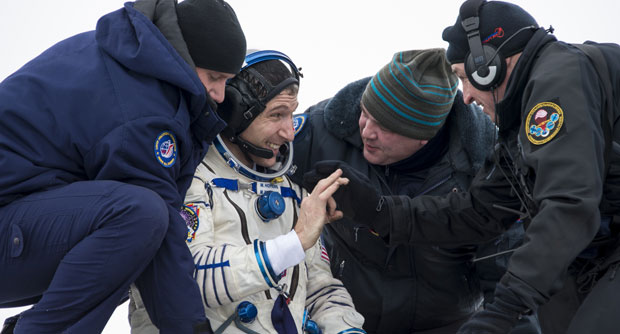
In this photo provided by NASA, Expedition 38 flight engineer Mike Hopkins, of NASA, gives a thumbs up as he is helped from the Russian Soyuz TMA-10M capsule that carried him, commander Oleg Kotov and flight engineer Sergey Ryazanskiy, of the Russian Federal Space Agency, after it landed in a remote area near the town of Zhezkazgan, Kazakhstan, on Tuesday, March 11, 2014. The astronauts returned to Earth after spending nearly six months on the International Space Station. AP
KARAGANDA— Two Russian cosmonauts and an American astronaut on Tuesday landed back on Earth in Kazakhstan after a stay aboard the International Space Station (ISS) of over half a year, which saw the Olympic torch paraded in space.
Russians Oleg Kotov and Sergei Ryazansky and NASA astronaut Mike Hopkins touched down in their Soyuz capsule at 0324 GMT outside Dzhezkazgan in Kazakhstan, mission control said.
The textbook landing in difficult weather conditions underlined the strength of space cooperation between the United States and Russia, despite the soaring diplomatic tensions over Moscow’s intervention in Ukraine.
The undocking and landing had initially been postponed due to bad weather with heavy snow and high winds at the landing site. But just hours before the undocking, they were allowed to go ahead and mission control said that the landing had proceeded on schedule.
The three spacemen were extracted from the capsule in good shape and wrapped with blankets to protect them from the fierce early-morning cold on the snowy Kazakh steppe.
During their mission Kotov and Ryazansky had, in a spacewalk watched around the world, carried into space the torch that was used to light the Olympic Flame for the Olympic Winter Games in Sochi.
Kotov, one of Russia’s most experienced cosmonauts, has notched up a total of 526 days in space, including previous expeditions in 2007 and 2009-2010.
Ryazansky and Hopkins were making their maiden flights.
‘The sparks fly’
The trio underwent medical checks on the spot before being loaded into an all-terrain vehicle that took them to a helicopter for the flight to the Kazakh city of Karaganda.
From there, the three are parting company, with Hopkins to be flown back to Houston and the two Russians to Moscow.
“You see the sparks flying, it’s pretty neat. It’s pretty exciting, incredible,” Hopkins, sat in a chair to deal with the effects of the return to Earth after months of weightlessness, said in comments heard on NASA TV.
“The one thing that hurts are my knees,” he added.
NASA TV said that the number of personnel around the landing zone had been kept to a minimum due to the poor weather conditions. Rescue crews stumbled around in the heavy snow.
Television pictures showed the burns and damage sustained by the capsule’s heat shield during re-entry.
The Soyuz capsule started undocking from the ISS at 2345 GMT Monday, with the departing astronauts leaving on board the station Koichi Wakata of Japan, the new ISS commander; American Rick Mastracchio; and Russian Mikhail Tyurin.
Wakata is the first ever Japanese astronaut to have command of the ISS.
The Soyuz capsule lands according to principles little changed since the first space flight of Yuri Gagarin in 1961, with a parachute helping the capsule to touch down safely on Earth after re-entering the atmosphere.
After the withdrawal of the US space shuttle, Russia is the sole nation capable of transporting humans to the International Space Station (ISS), and spaceflight is often hailed as the finest example of Russian-American cooperation.
NASA chief Charles Bolden said last week that the US space agency’s relationship with Russia remained normal despite the rising tensions over the crisis in Ukraine.
The next crew of NASA astronaut Steve Swanson and Russians Alexander Skvortsov and Oleg Artemyev are due to launch to the ISS from the Baikonur cosmodrome in Kazakhstan on March 25.
RELATED STORY

